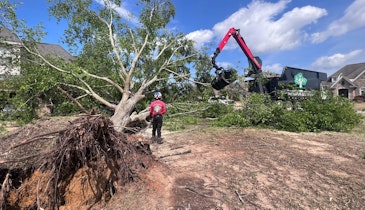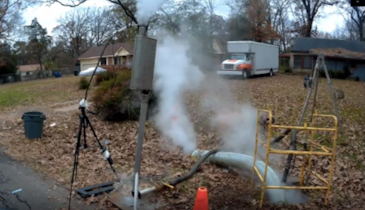
The team at the Fair Oaks Ranch Wastewater Treatment Plant includes, from left, Roland Rios, utility operator; Brandon Garrettson, plant supervisor; and Bill Champion and Juan Ramirez, utility operators.
Interested in Wastewater?
Get Wastewater articles, news and videos right in your inbox! Sign up now.
Wastewater + Get AlertsWhen a wastewater treatment staff literally lives at the plant for five straight days during an ice storm, you’d expect them to win an award.
That’s exactly what happened at the Fair Oaks Ranch Wastewater Treatment Plant, a few miles west of San Antonio. The 0.5 mgd (design) operation won the 2022 Water Environment Association of Texas Small Plant of the Year award, for operator dedication but also for a superior record in water quality and safety.
“We’ve had no compliance issues for the past two years,” reports Brandon Garrettson, plant supervisor. And he has nothing but praise for the staff: “During the 2021 winter storm, everything was iced over. But the plant and collection system continued to operate without service interruption. Staff stayed and lived on site Feb. 14-19. They caught problems before they became significant issues.”
Effective operation
The Fair Oaks Ranch treatment plant used to be run by a private company. Operations returned to the utility in 1998. The transfer has proved beneficial in many ways. Besides the absence of permit violations, the plant employs a multistep safety program that includes weekly safety meetings; facility, equipment and vehicle safety inspections; and third-party training. As of last September, the wastewater department had seen no lost-time incidents for a year.
Garrettson points out that although the plant only requires Class C operators, the utility encourages team members to pursue the highest level of licensing.
Wastewater is collected from 2,100 residential connections and is fed to the plant via gravity and six lift stations. Treatment begins with an influent bar screen (Vulcan Industries). The flow continues to an in-yard lift station and then to a 350,000-gallon-capacity continuous-loop reactor, aerated with two Eimco turbo blowers (Ovivo).
Two circular secondary clarifiers (Envirodyne) follow, and the overflow is disinfected with chlorine gas. The purified effluent is pumped to the Fair Oaks Ranch Golf Course to irrigate the grounds and fairways. A SCADA system for automation and control was added in 2012.
Biosolids management was one of the Fair Oaks Ranch plant’s biggest challenges. Biosolids used to be spread on drying beds next to the plant, after which the dried cake was hauled to a landfill. But since the plant is close to a residential neighborhood, the beds caused odor complaints.
To address that, the plant turned to wet hauling, but that is expensive: Garrettson estimates annual hauling costs and landfill tipping fees at more than $300,000. Now the team is installing an Amcon dewatering press using volute technology from PWTech.
Selected after a study by staff and consultants, the press produces cake that Garrettson says is “like Play-Doh” and emits no odors. Cake hauling costs to landfill are expected to be far less than with wet material. The press promises to pay for itself in about three years and is designed to handle all current and projected volume.
Process improvements
Since the city took over operations, the plant has passed all Texas Council on Environmental Quality inspections and has received just one notice of violation, that due to odor complaints. “Under the city’s ownership, the plant has also gone through multiple upgrades to improve its operation,” says Garrettson. “However, we are still playing catch-up.”
Along the way, the plant staff has confronted several issues. Fair Oaks Ranch recently implemented a new camera inspection and jetting program for the collection system to identify any infiltration areas that could affect plant operations. The program aims to reduce infiltration and help identify needs for future collection system improvements.
As in most wastewater operations, clogs in lift stations have been an issue, especially from wipes flushed during the COVID pandemic. The collections staff developed a monthly cleaning program that has helped greatly. The utility is also using an enzyme block quarterly to reduce grease at six specific lift station locations.
The wastewater treatment plant also went through its first significant repair to its in-yard lift station. “It required the lift station to be taken out of service,” Garrettson says. “That had never been done or attempted before due to the complexity.”
The staff installed a bypass line from the force main, allowing half the flow of the in-yard station to be redirected. Then they created a bypass for the gravity line to enable operations to continue uninterrupted during the repair project.
Garrettson reports, “The bypass required plugging the inlet pipe to the in-yard lift station. Blocking the line backed up the flow into a small splitter box, where the staff set two diesel-driven pumps operating on floats.”
Staffing up
The Fair Oaks Ranch plant is staffed from 7:30 a.m. to 4:30 p.m. daily, and one operator is on call at other times. Besides Garrettson, the staff includes Steven Fried, water quality supervisor; Roland Rios, lead wastewater operator; Bill Champion, William Poole, Eddie Merrill and Jarrett Lee, operators; and Juan Ramirez and Garrett Sharp, utility technician.
Tobin Maples is city manager. Grant Watanabe is director of public works, and Julio Colunga is assistant director. Sandra Gorski is public works administrative assistant, and Katherine Schweitzer is city engineer.
As of September, one operator slot at the treatment plant remained open, and the utility was on the lookout for a suitable candidate. “It’s hard to find people interested in this field,’” says Garrettson. Texas may have a partial solution: the WEAT is launching an apprentice program using state and federal funding to help pay for training new people.
According to the association’s website, the program supports employers by helping identify apprenticeship candidates and providing funds for training on the job and in the classroom. Financial assistance flows directly to the participating utility.
The apprenticeship provides access to additional benefits for veterans to support their entry into the workforce. The program also seeks to benefit high school students and educators by bringing awareness to the field and enabling students to experience their career via internships and tours.
Garrettson also works with the city’s human resources department to fill open positions.
Expansion and growth
Fair Oaks Ranch faces future growth. Its population, now 12,000, is expected to reach 16,000 in the years ahead. Garrettson says his utility is faced with aging infrastructure and has initiated a master plan. Expansion or new construction is on the horizon.
“Our average flow is around 240,000 gpd,” he says. “As it increases, we will need to have a plan in place to handle the additional flow. Right now, we are doing an engineering study to determine what we will need to do.” The master plan identified a financial gap with future funding, leading to the utility’s first-ever rate study.
Weather remains an uncontrollable challenge. Summers can become unbearably hot, causing some outside motors to overheat and trip out. To keep them cooler and ensure continuous operation, the Fair Oaks Ranch staff uses canopies to provide shade.
Winter can be even worse. Ice storms and unusually cold temperatures can severely hamper operations. The storm of 2021 sent temperatures plummeting to depths seldom seen in south Texas. The staff had to deal with freezing pumps, loss of power, setting up backup generators and emergency pumps when needed, and salting driveways and walkways.
The workload was so great, and travel around town so hazardous, that staff bunked in at the plant for several days. “Our flows got up to around a million gallons a day,” Garrettson recalls. “With lift stations and pumps freezing up and power outages, it was a big juggling act. None of our lift stations have emergency generators. The roads were sheets of ice.”
It was a weeklong serious freeze during which thermometers hit single digits. Garrettson recalls, “The sacrifice of being away from family was not easy. However, the city and its residents greatly appreciated it.” he says of his staff. There’s an extra measure of satisfaction in the award plaque that now hangs on the wall.
This article was originally posted May 2023.





